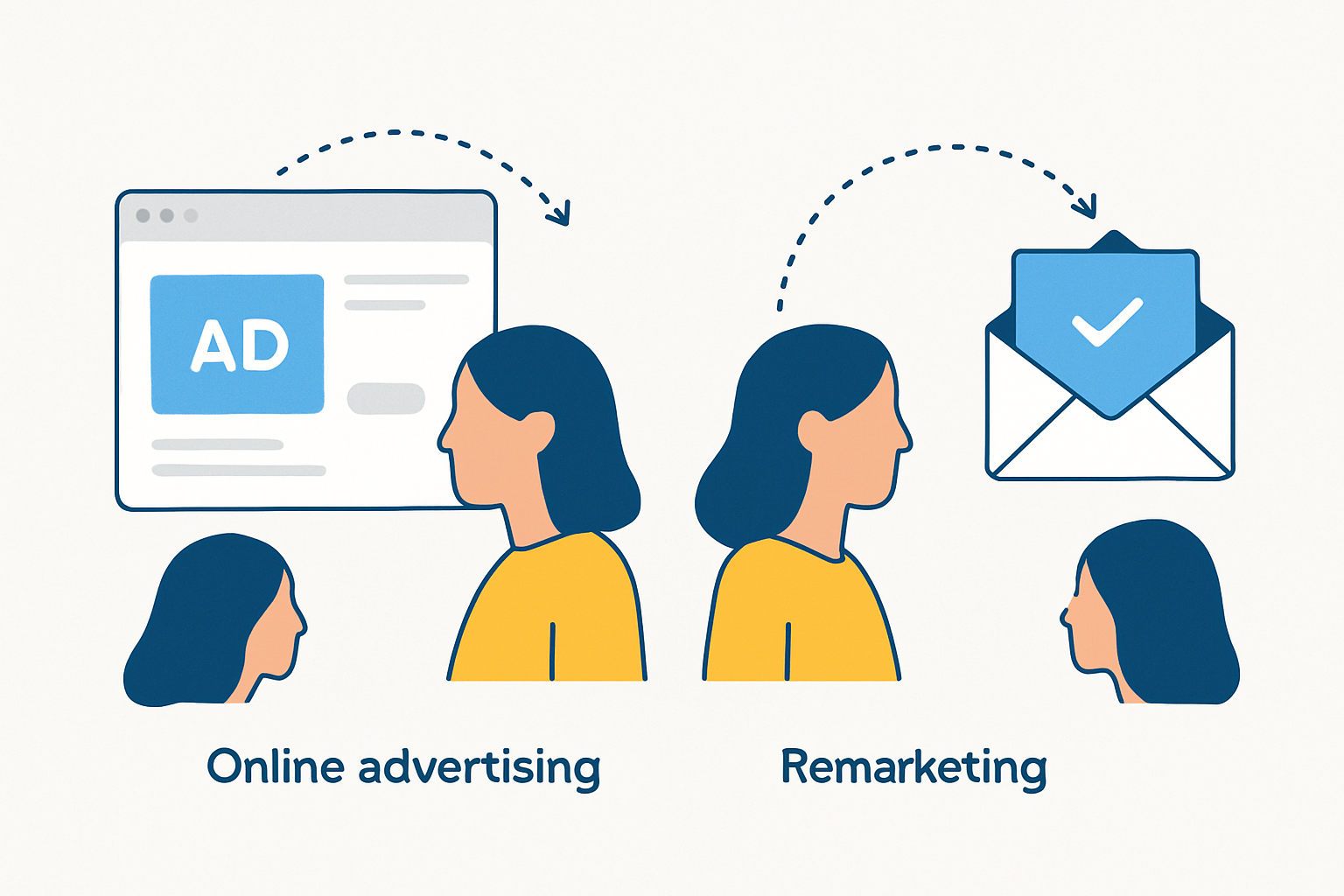
Which health affiliate marketing programs are the best?
Explore the best health affiliate marketing programs of 2024 and learn how to boost your earnings wi...

Many marketers often stumble upon the terms retargeting and remarketing and wonder if they’re just two sides of the same coin or if there’s more to the story. While these buzzwords are linked and sometimes used interchangeably, they describe distinct strategies that tackle different marketing goals. Understanding the nuances between retargeting and remarketing can be a game-changer for businesses looking to craft sharper campaigns, make smarter budget choices and genuinely engage their customers.
Retargeting and remarketing both hail from the digital marketing playbook, but they are not precisely twins. Retargeting typically means showing ads to individuals based on their browsing habits, often relying on data like cookies—those little trackers that follow you around the internet. Remarketing usually zeroes in on past customers or leads directly, often by sending emails that gently nudge them back.
Retargeting keeps an eye on how individuals interact with your website or digital content and then serves up tailored ads as they wander around other sites. It works by leaving little digital breadcrumbs—cookies and tracking pixels create a trail that helps advertisers stay in touch with potential customers.
When someone stops by a website or interacts with digital content they leave behind a small data footprint.
A tracking pixel or cookie sneaks into their browser to quietly gather behavioral info.
If the visitor decides to leave without completing a desired action like making a purchase,
Retargeting platforms then nudge that user with ads across places like the Google Display Network or Facebook as they surf other sites.
The goal is to coax them back and seal the deal on the original site, turning maybe into a definite yes.
You know, remarketing with email and CRM strategies is kind of like giving a friendly nudge to someone who is already shown interest. It’s not about bombarding inboxes but more about staying on your audience’s radar without coming off as pushy. Typically, you start by gathering data from your CRM—think of it as your trusty Rolodex, just way more high-tech—and then tailor your emails to match what your customers really want. It’s all about timing and relevance, sending that right message at just the right moment, like catching someone exactly when they’re ready to take action. And believe me, when done right, this dance between email and CRM can turn casual browsers into loyal fans, often without them even realizing they’ve been swept off their feet.
Remarketing is all about circling back to your existing audience, usually through emails or trusty customer relationship management tools. When people hand over their contact details, remarketing swoops in with tailored nudges—think of an email reminding you about that forgotten shopping cart or a special deal that’s perfectly suited to your past purchases.

Visual comparison of retargeting through display ads and remarketing through email communications.
| Aspect | Retargeting | Remarketing |
|---|---|---|
| Definition | Targeting anonymous visitors on your website with display ads using cookies and pixels — a bit like gently waving to someone passing by without knowing their name. | Reconnecting with known users or customers through email or CRM data, reaching out to familiar faces you have met before. |
| Channels used | Display networks, social media ads, and programmatic ad platforms where those ads seem to follow you around (in a not-too-creepy way). | Email, SMS, and CRM platforms—basically the tried-and-true channels for a more personal touch. |
| Data sources | Behavioral data gathered from browser cookies and pixels, tracking what people peeked at but maybe didn’t grab. | Customer contact details and transaction data pulled straight from CRM systems, the goldmine of customer info. |
| Typical goals | Turning cold or warm leads who didn’t quite seal the deal into paying customers, giving them a friendly nudge or two. | Building relationships with existing leads or encouraging repeat purchases because everyone loves a little friendly reminder. |
| Common tactics | Dynamic ads showing products previously ogled, along with campaigns that chase after those who left your site mid-shopping spree. | Personalized email sequences and cart abandonment reminders that feel more helpful than pestering. |
| Metrics tracked | Impressions, click-through rates, conversion rates, and cost per acquisition—numbers that tell the story of who’s sticking around. | Open rates, click rates, conversion rates, and unsubscribe rates, giving you a pulse on how your messages land (or don’t). |
This table lays out the difference between retargeting and remarketing in digital marketing. Retargeting taps into anonymous data picked up through ad technology to throw ads at potential customers—great for casting a wide net and grabbing attention on a larger scale. Remarketing, on the other hand, leans on personal contact info stored in CRM systems to send tailored messages. This approach nurtures stronger bonds with leads or existing customers. Understanding these nuances helps marketers craft campaigns that play well together and squeeze the most out of their budget and channel choices to boost their ROI.
Retargeting usually shines when reaching anonymous visitors who popped by your site but didn’t take the plunge. It’s a handy tool for gently introducing your products and keeping your brand in their minds. Remarketing works better with warmer leads or existing customers and serves tailored messages to nurture loyalty and encourage repeat business. When you combine the two strategies, you cover all your bases by guiding people from the first spark of interest through to the important post-purchase follow-up.
Use retargeting to gently nudge those website visitors who browsed your products but didn’t quite take the plunge.
Run remarketing campaigns to reconnect with your email subscribers and give those leads a little extra push toward becoming loyal customers.
Launch retargeting ads for limited-time or flash sales to crank up that all-important sense of urgency—because who can resist a ticking clock?
Use remarketing to reward your loyal customers with tailored promotions that feel more like thoughtful gifts than generic ads.
Combine retargeting ads with remarketing emails to create a well-coordinated multi-channel campaign that really spreads your message far and wide.
Successful retargeting usually hinges on having well-defined audience segments, making sure ad frequency does not annoy users and crafting personalized creatives that resonate with their past interactions. Sticking to privacy rules like GDPR by obtaining the right consent for tracking is not just a box to check—it is vital for keeping trust intact.
Remarketing emails need to feel personal and timely to grab the attention of leads meaningfully. Using user data to tailor messages, testing subject lines and content through A/B testing, and pacing how often you send them all help keep people interested without pushing their buttons.
Retargeting and remarketing often get tangled up in conversation because marketers and platforms tend to toss the terms around like they mean the same thing. Some individuals swear they are identical while others draw a line in the sand: retargeting focuses on ads and remarketing on email campaigns. Clearing up this confusion is key to setting realistic expectations and making sure each method is used to its best advantage.

Explore the best health affiliate marketing programs of 2024 and learn how to boost your earnings wi...

Unlock your clothing brand’s growth potential with top apparel affiliate partnerships. This guide of...

Is content marketing dead for small businesses? Discover why this belief persists, the truth behind...

Unlock the power of perfectly sized social media photos with our ultimate 2024 cheat sheet. Boost en...